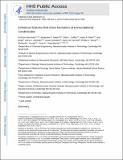Enhancer Features that Drive Formation of Transcriptional Condensates
Author(s)
Shrinivas, Krishna; Sabari, Benjamin R; Coffey, Eliot L; Klein, Isaac A; Boija, Ann; Zamudio, Alicia V; Schuijers, Jurian; Hannett, Nancy M; Sharp, Phillip A; Young, Richard A; Chakraborty, Arup K; ... Show more Show less
DownloadAccepted version (2.304Mb)
Publisher with Creative Commons License
Publisher with Creative Commons License
Creative Commons Attribution
Terms of use
Metadata
Show full item recordAbstract
© 2019 Elsevier Inc. Enhancers are DNA elements that are bound by transcription factors (TFs), which recruit coactivators and the transcriptional machinery to genes. Phase-separated condensates of TFs and coactivators have been implicated in assembling the transcription machinery at particular enhancers, yet the role of DNA sequence in this process has not been explored. We show that DNA sequences encoding TF binding site number, density, and affinity above sharply defined thresholds drive condensation of TFs and coactivators. A combination of specific structured (TF-DNA) and weak multivalent (TF-coactivator) interactions allows for condensates to form at particular genomic loci determined by the DNA sequence and the complement of expressed TFs. DNA features found to drive condensation promote enhancer activity and transcription in cells. Our study provides a framework to understand how the genome can scaffold transcriptional condensates at specific loci and how the universal phenomenon of phase separation might regulate this process. Shrinivas et al. demonstrate that specific types of motif compositions encoded in DNA drive localized formation of transcriptional condensates. These findings explain how phase separation can occur at specific genomic locations and shed light on why only some genomic loci become highly active enhancers.
Date issued
2019Department
Massachusetts Institute of Technology. Department of Chemical Engineering; Massachusetts Institute of Technology. Institute for Medical Engineering & Science; Whitehead Institute for Biomedical Research; Massachusetts Institute of Technology. Department of Biology; Koch Institute for Integrative Cancer Research at MIT; Massachusetts Institute of Technology. Department of Physics; Ragon Institute of MGH, MIT and Harvard; Massachusetts Institute of Technology. Department of ChemistryJournal
Molecular Cell
Publisher
Elsevier BV